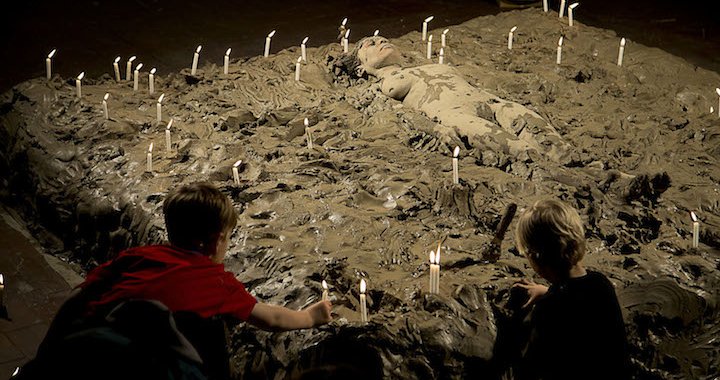
not an exhibition - nor a performance
Anne Neimann Clement
14/11/2014
Photos: Frida Nygaard Christensen
Lilibeth Cuenca Rasmussen “being human being”
Nikolaj - Copenhagen Contemporary Art Centre, Copenhagen
Until January 25, 2014
In the Upper Gallery in the old church - and now art space - Nikolaj - Copenhagen Contemporary Art Centre, white banners with clay footprints are hanging down from the ceiling. Against the walls lean white canvases with clay-kisses and handprints. The floor is decorated with hundreds of small clay figures, and from eight speakers a sound piece by Berlin-based sound artist Jacob Kirkegaard may be heard.
All this bears witness to a lot of activity that has lately taken place in the gallery. They are all part of video- and performance artist Lilibeth Cuenca Rasmussen's exhibition being human being, which is open for exploration in the Nikolaj - Copenhagen Contemporary Art Centre until 25th of January 2015.
In being human being, Lilibeth Cuenca Rasmussen invites us to investigate the origin of man with her. The exhibition examines the way we search for, see, and display our existence’s origin and how this influences the way we understand ourselves today. The exhibition is based on geological studies of the Earth's structure and evolution, and on the artist's recent expedition to Ethiopia, where the first humans are said to have taken the first step away from life as great apes, and into the life of Homo Erectus. With seven four-hour-long performances, she poses questions like "Why are we here?" and "Where do we come from?"
However, before the following article provides the answers to these questions, Lilibeth Cuenca Rasmussen deserves a proper introduction.
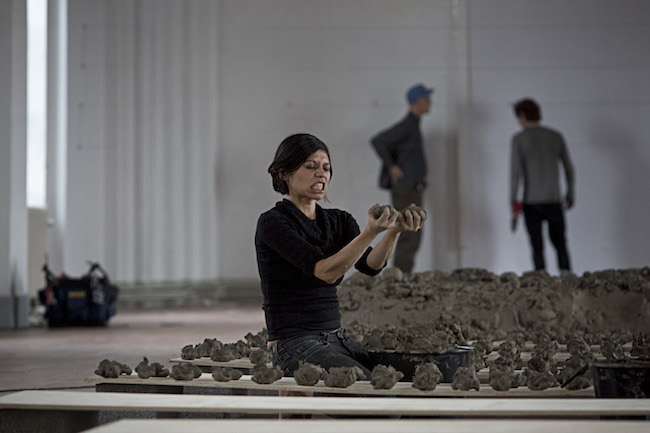
An Introduction to the artist
Lilibeth Cuenca Rasmussen was born in Manila, in the Philippines, in 1970. As her father is Danish, the family moved to Denmark when she was eight years old. Her cultural background is often a point of departure in her artworks.
Lilibeth Cuenca graduated from The Royal Danish Academy of Fine Arts in Copenhagen in 2002. Her artistic breakthrough came with the music video FAMILY SHA LA LA (1998), in which she invited her parents and siblings to perform a choreographed piece to a well-known pop song with her. With her video ABSOLUTE EXHOTIC (2005), in which she, dressed in only a flower necklace and a grass skirt, raps about her boyfriend who has left her for a black woman, she has marked herself as an iconic and important voice in contemporary performance and video art.
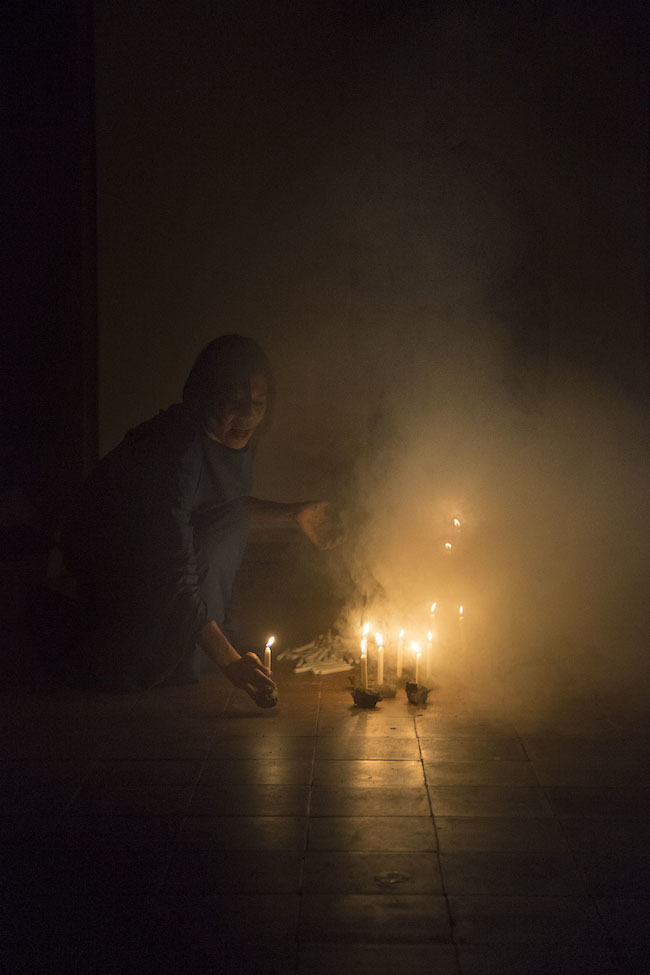
Lilibeth Cuenca is a pioneer in contemporary performance both in Denmark and internationally. In her practice, she often transforms her actions into different materials and media such as video, photography, sculpture, painting and installations. Her works involve scripted texts, songs and composed music, as well as intricate visual elements such as set design and costumes. With both a critical and a humorous approach, she gathers and adapts narratives with regard to issues such as identity, culture, religion, politics, gender and social relations. With style and curiosity, she navigates between different kinds of realities and relations: Between personal experiences and global commitment: Between the perfect and the kitsch: The absurdity and the harshness of life.
Lilibeth Cuenca Rasmussen questions both women’s place in art history and the female identity as such. Her artistic grandfathers and grandmothers are to be found among the FLUXUS and Arte Povera people. Like them, she is interested in time, volatility, and body. being human being is not an exception, but this time materiality seems even more important. "Earlier on, I was only concerned about the performance and the now. Now my focus has changed to also include what remains after the bodily presence in time. The materials have become very important."
When Lilibeth Cuenca Rasmussen started doing her performances, she was more or less the only visible performance artist in Denmark, but recently we have seen an increased interest in performance art. Many institutions have realized the relevance of live art as an innovative and important contemporary art form and are presenting performance programs as part of their exhibition calendar. We are seeing a new attitude towards performance. It's being perceived more as something that appeals to a big audience, and not an exclusive or intellectual happening. Sociologist Esa Nickle has announced performance art to be the new public art form because of its ability to communicate directly with the audience.

Co-creation and live art
All objects in being human being have been created in collaboration with others. Four hours a day, for seven days in a row, Lillibeth Cuenca has carried out seven performance sessions. Together with her two siblings, her parents, daughter, three fellow artists, a dancer, a sound artist, and, last but not least, the common guest in the gallery, she has made art works with butter, earth, clay, and canvas as her primary materials.
One day she did pirouettes in clay with dancer and choreographer Kasper Ravnhøj, creating small clay sculptures. On the opening evening she performed a spiritual ritual with the Ethiopian multimedia artist Mihret Kebede, accompanied by Jacob Kirkegaard's sound recordings from Ethiopia. On the Danish Culture Night, she lay naked in clay on a podium, inviting the audience to light candles and form the clay around her as a tribute to Lucy - the first standing person whose remains were found in Ethiopia. Thus, the bodily experiences and material investigations that have taken place prior to the opening are both the media and the message.
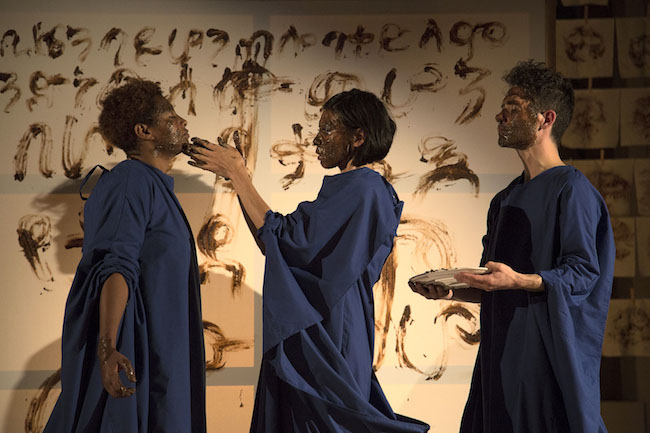
The traces of the live art that has taken place in the gallery are beautiful enough, but as artworks they miss some thoroughness, finesse, or originality. Maybe it has a point, now that it is all about origin and becoming, but even if that is the case, the exhibition still misses something more to take us all the way back to the history of man and the first standing human being – as the introductory text at the entrance promises.
Nevertheless, the exhibition gains a lot from the beautiful exhibition space of Nikolaj Church. The themes of the exhibition (genesis and origin, language, relations, and the human search for meaning) interact interestingly with the old historical building, and the high opportunity for participation is both sympathetic and appealing.

A discussion on documentation and the aesthetics of performance
When one of the founders of Performance Studies International, Peggy Phelan, wrote the ontology of performance, she claimed that performance cannot be saved, recorded, documented, or otherwise represented. If it does so, the performance enters the economy of reproduction, and it betrays the promise of its own ontology.
In being human being, the documentation does not only document the events, it is the event. Filming, photographing, and posting installation-updates on social media are part of organizing the exhibition. In contrast to the romantic idea of the artistic genius who creates his work alone, the artworks in being human being are not isolated objects that can be understood apart from their origin. As the artist puts it: "When there weren't a lot of people, I got insecure about whether we should perform, talk, or produce. But the camera was there all the time, even when the audience didn't show up."
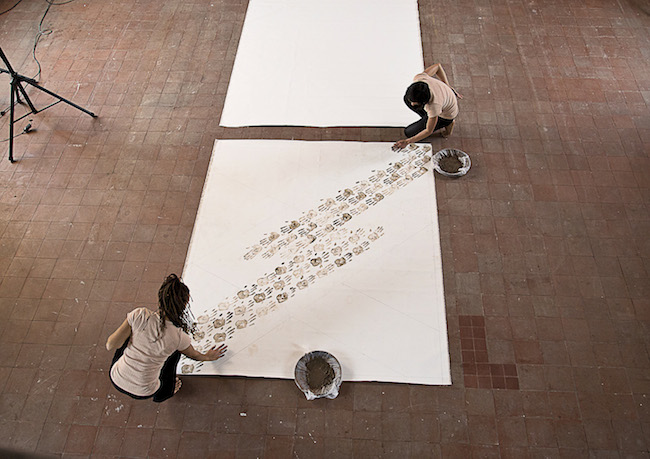
As regarding the visitors, documentation is also a part of the experience. On the opening evening, more than half of the audience (myself included) were experiencing the performance through their smart phones. This is not an outstanding thing for being human being, but a tendency that pervades our society in general.
being human being is not really an exhibition, nor is it a performance. It's something in between. What we explore is an open studio or a program of live art in which we witness artistic research and the formation of artworks. Unfortunately, the energy of the live dimension fades as the days pass by. And when the performative now is extended for hours, as is the case in being human being, it lacks the intensity and presence that is one of the main qualities of performance.